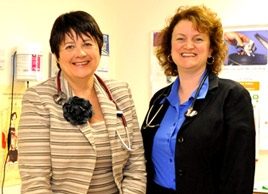The rise of nurse practitioners in Canada
Doctor shortages are putting a strain on our healthcare system. Nurse practitioners could be one way to relieve it

Source: Best Health Magazine, November/December 2008; photo by Tony A. Galic/Candid Photography Studios
One day this past July, a 41-year-old woman walked into a clinic for her annual checkup. After a Pap smear and blood pressure reading, she got a renewal prescription for her thyroid medication and advice on how a family history of diabetes affected her risk.
The examination, prescription and medical advice were not from a doctor, but from a nurse practitioner (NP): Marilyn Butcher, director of Canada’s first NP-led clinic. “This is the first time a group of nurse practitioners has formed a non-profit organization, created a board and received funding,” says NP Roberta Heale, the clinic’s co-founder.
This take-charge move has put NPs in the national spotlight. The Sudbury, Ont., clinic got accolades from Ontario Premier Dalton McGuinty, who announced funding for 25 similar clinics after it opened in August 2007. Since then, NPs from coast to coast keep calling Heale and Butcher, asking how they did it. And while this is the country’s first NP clinic, it’s not likely to be the last.
The history of nurse practitioners in Canada
Canada started training NPs in 1967, and we now have more than 2,000. NPs do everything from diagnosing and managing chronic diseases to treating ear infections, ordering tests and writing prescriptions. They also focus on disease prevention. But Butcher insists their role is not that of a physician. “NPs are registered nurses with additional training, experience and education that enables us to practise nursing in an expanded role,” she says. When patients have complex diagnoses or need help to manage a serious condition such as out-of-control diabetes, Butcher collaborates with the physicians associated with her clinic.
The idea for the Sudbury clinic came in 2005 when Heale and Butcher, who had worked together at the Victorian Order of Nurses, were frustrated with their careers. Butcher, married with two children in their 20s, was piecing together an income doing several casual NP jobs. Meanwhile, Heale, also married and with two teenage daughters, had turned to teaching in the NP program at Sudbury’s Laurentian University since there were few jobs in the field. The two knew of eight NPs in the area working as regular nurses, and of many more who were underemployed.
To further their profession—and help the 30,000 people in Sudbury without a family physician—Heale and Butcher lobbied for funding from the Ontario Ministry of Health and Long-Term Care. By summer 2007, they had received government funding and opened their clinic.
The clinic’s successes and goals
During its first year, the clinic was bombarded with calls. It gradually took on about 1,400 patients, and continues to accept new ones. It is currently staffed by three full-time NPs; Butcher herself sees patients part-time (Heale, still at Laurentian and president of the clinic’s board, doesn’t work hands-on). Appointments range from 15 to 30 minutes. Two doctors join the group two to three days a week in total. “We don’t have the doctors doing annual health exams or prenatal checkups. We want to use everyone’s skills to the fullest,” says Butcher. Eventually, the pair plan to open a second location to accommodate 4,500 patients, and to include two more NPs, a dietitian, a social worker, a registered nurse and a pharmacist.
Dr. Tara Leary, one of the clinic’s doctors, likes its collaborative approach. “I think that patients are getting excellent care. It’s like having two primary caregivers at one number. You can’t beat that.”
Are nurse practitioner clinics effective?
Heale and Butcher have surveyed their patients and found they are happy with the clinic’s approach. And international research confirms that NPs can work: A review of 34 studies, published in the BMJ (British Medical Journal), found that NPs kept people just as healthy as doctors, and patients were more satisfied with their care.
Still, “there’s a huge lack of public awareness about the role,” Butcher admits. As well, NP education and scope of practice are not standardized across the country. To address these and other issues, the Nurse Practitioner Council of Canada was formed.
While The College of Family Physicians of Canada does not have an official position on NPs, some doctors have voiced concerns. “A nurse practitioner cannot provide a doctor’s care,” says Dr. Ken Arnold, president of the Ontario Medical Association. He thinks the Sudbury clinic should be assessed to be sure people are getting the best care possible.
Choosing to see a nurse practitioner instead of a doctor may not be for everyone. But for many, this new type of clinic is a great way to stay well.
Pictured: Marilyn Butcher (left) and Roberta Heale are the founders of Canada’s first nurse practitioner-led clinic.
This article was originally titled "Beyond Nursing," in the November/December 2008 issue of Best Health Magazine. Subscribe today and never miss an issue!




